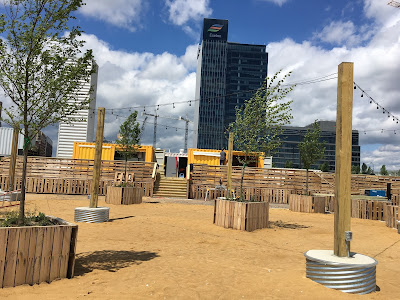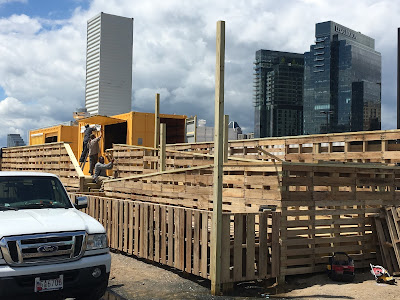To sooth passengers' potential wrath, they will get two weeks of free bus rides in June. This may well be needed, given that change is hard and that transit agencies are about as well liked as cable companies, no matter where in the country. BaltimoreLink's promise of doing more with essentially the same resources is alluring, who would not want to root for that? Success or failure will have far reaching implications:
A recent study by Harvard economists found that the single strongest factor affecting the odds of a child escaping poverty is not the test scores of his or her local schools or the crime in the community; it is the percent of workers in his or her neighborhood who have long commutes. And among the nation's 100 largest cities, the one where children face the worst odds of escaping poverty is Baltimore City. (Donald Fry, Thomas Wilcox editorial)Baltimore moves comparably many people on buses, about 220,000 per day according to latest counts. That puts this region on rank 10 in a national score of passenger miles on transit per 100,000 people while we are on rank #29 in population size. There certainly are other US metro areas that are worse off in terms of transit. But this consolation shouldn't make complacent. Successful metro areas can't compete with the bottom half, they have to compete with the top places, nationally and internationally, especially since Baltimore has to overcome major inequalities. And in such an arena, better functioning buses will not suffice.
New Baltimore transit system map
BaltimoreLink does a piece of [jobs access], but by no means is it the significant investment (mass) transportation really needs in the region and the state,” Dru Schmidt-Perkins,CEO 1,000 Friends of Maryland in today's Daily Record
 |
| The Baltimore Rail Plan that wasn't |
Residents of the greater Baltimore region are used to bad transit news. The cancellation of the nearly $3 billion Baltimore Red line after 12 years and a quarter billion dollars of planning and design expenses is just the most egregious case which called attention nationwide.
Bad transit news are numerous even in the DC area which Baltimore used to envy for its marvelous subway system. It is now so overloaded that emergency repairs and outages are testing rider's patience on a daily basis. Our own single line Metro and Light Rail also need major track and system repairs, and like the DC system, new or overhauled train cars. Falling light rail, Metro and bus ridership here and in DC due to continuing low gas prices doesn't help.
Now Maryland's second large rail transit project, the 2.5 billion Purple Line, hangs in the balance because of a court case. This is not too far away to bother, because economically and in terms of mobility Baltimore is part of the mega region that includes DC and Wilmington as well. That is easily how far commute-sheds reach nowadays.
 |
| Denver FasTrack map: Many lines are now running |
People hate the comparison with Europe where gas is very expensive, development more compact and transit wonderful by comparison. But access of a region from the outside is also an important aspect, and the less that access is dependent on air travel, the more sustainable it is. My former hometown of Stuttgart (population 623,000) has 15 train tracks for long distance and regional trains alone with dozens of trains arriving and leaving every hour of the day with so many travelers per day that the station reaches Baltimore's Penn Station annual passenger volume every 4.5 days. From there one can reach Paris, London and Vienna, and Berlin all in no more than 6.5 hours at speeds of 155 mph.
Baltimoreans can get to New York and DC in a reasonable time, but Boston already takes too long and Chicago is a veritable joke with 19 hrs on Amtrak (11hrs by car). Arriving at Stuttgart's main line station lower levels eight light rail and commuter tracks allow access to the entire metro region on the same ticket often with head-ways as low as six minutes. Arriving in even far-flung stations, buses will wait to take riders even further into the hinterlands. Stuutgart is not unique. Strasbourg (pop. 456,000), Manchester (pop. 530,000) or Zurich (pop. 396,000) would offer similar transit options. Even Union Station in DC, a wonderful local transit hub has a hard time to hold up in such a comparison because of the fare-card chaos in which there no uniform multi-modeal regional ticket exists because each of the dozens of local transit systems at the outer terminal stops has its own fare system, no matter how limited the service.
We don't need to compare ourselves with Europe or the big cities of New York, Chicago or Philadelphia to get transit-envy. A trip to Charlotte, NC, Seattle WA, Minneapolis MI or San Diego, CA would suffice to show how cities with much less transit conducive DNA, i.e. lower density and lacking any meaningful Amtrak service, can sport a fledgling but growing light rail network as the fruit of plans conceived at the same time as the Baltimore area rail plan of 2002.
 |
| Charlotte, NC |
The comparison of transportation systems is not a meaningless exercise of transit geeks but a matter of social justice, equity, health and economic development at its core. It is estimated that there are some 60,000 poor people in the Baltimore region who cannot access the jobs via transit and without a car, people who have no chance of leaving poverty because of the missing mobility. Low "opportunity" areas have routinely the longest commute times to well paying lower skill jobs. Employers can't get employees and employees cant get jobs, not a trivial matter but severely curtailing what the region and its people.
Every time a metro area added about 4 seats to rails and buses per 1,000 residents, the central city ended up with 320 more employees per square mile — an increase of 19 percent. Adding 85 rail miles delivered a 7 percent increase. A 10 percent expansion in transit service (by adding either rail and bus seats or rail miles) produced a wage increase between $53 and $194 per worker per year in the city center. (Chatman study, 2013)Transportation is seen more and more as a matter of social justice. Poor transit is another of the many ways how Baltimore has become so segregated. Transportation is a major cost factor especially for the poor. The answer isn't only access to well paying jobs; reduction of transportation cost itself puts more money into the pockets of the poor. There are many reasons beyond race and poverty to promote more and better transit: A growing number of disabilities prevent an ever larger number of people from driving; a growing cohort of aging baby-boomers will be less and less able to rely on the car as the only way of getting around; the large cohort of Millennials is hobbled by college debts, stagnant wages and, in general, has long become famous for looking how to avoid the big expenditure of an individually owned car.
 |
| San Diego: Trains and TOD |
What the Baltimore region needs isn't just an update of the well reasoned 2002 rail plan which showed 66 new rail miles in addition to the 43 existing rail miles of Metro and Light Rail, none of which were built. As much as the region needs such a new plan, it has to do more than showing new rail lines on a map, each costing billions of dollars and taking decades to realize. A comprehensive mobility vision for the region has to
- include DC and the Wilmington region as well as Annapolis and Frederick,
- integrate all transit systems in those regions into a seamless system regardless of mode.
- work across all modes including cars, water transit. bicycles and walking
- provide a comprehensive approach to the "last mile" problem
- provide better equity and connect opportunity areas with low opportunity area
- include land use and real estate
New technologies will blur the line between transit and taxi with demand-based van shuttles or fleet vehicles operating similar to Uber. Tampa Bay Transit and other agencies are experimenting with their own such service for a fixed extra fee. A new regional plan has to anticipate autonomous cars, vans, buses and trains. Those will completely reshuffle the current cost structure of existing transit which is highly driven by the fixed cost of the operator.
 |
| The entire network with one ticket: Stuttgart regional transit compact |
A new regional transportation plan cannot chase the remotest jobs in places where transit will never work with whatever technology. Instead, such a plan needs to show ways to put more uses where the existing transit assets are. Stations sit all too often in areas that are best described as holes in the doughnut. The current Secretary of Transportation doesn't want to deal with the real estate side of transportation and doesn't consider it part of his job. Without it, though, ridership on existing facilities will continue to drop, jobs will remain out of reach and poverty will continue to fester around many current station areas.
The goal of making what we have work better as expressed in BaltimoreLink is a basic and necessary step. But without additional resources for better connectivity, more choices and much better integration efforts of doing more with the same are destined to fail. There is no way around the fact that a true regional mobility system will require significant investments. If any of our competing metro regions are any indication, the return on those investments would be high.
Klaus Philipsen, FAIA









































